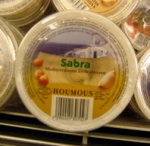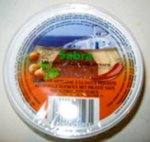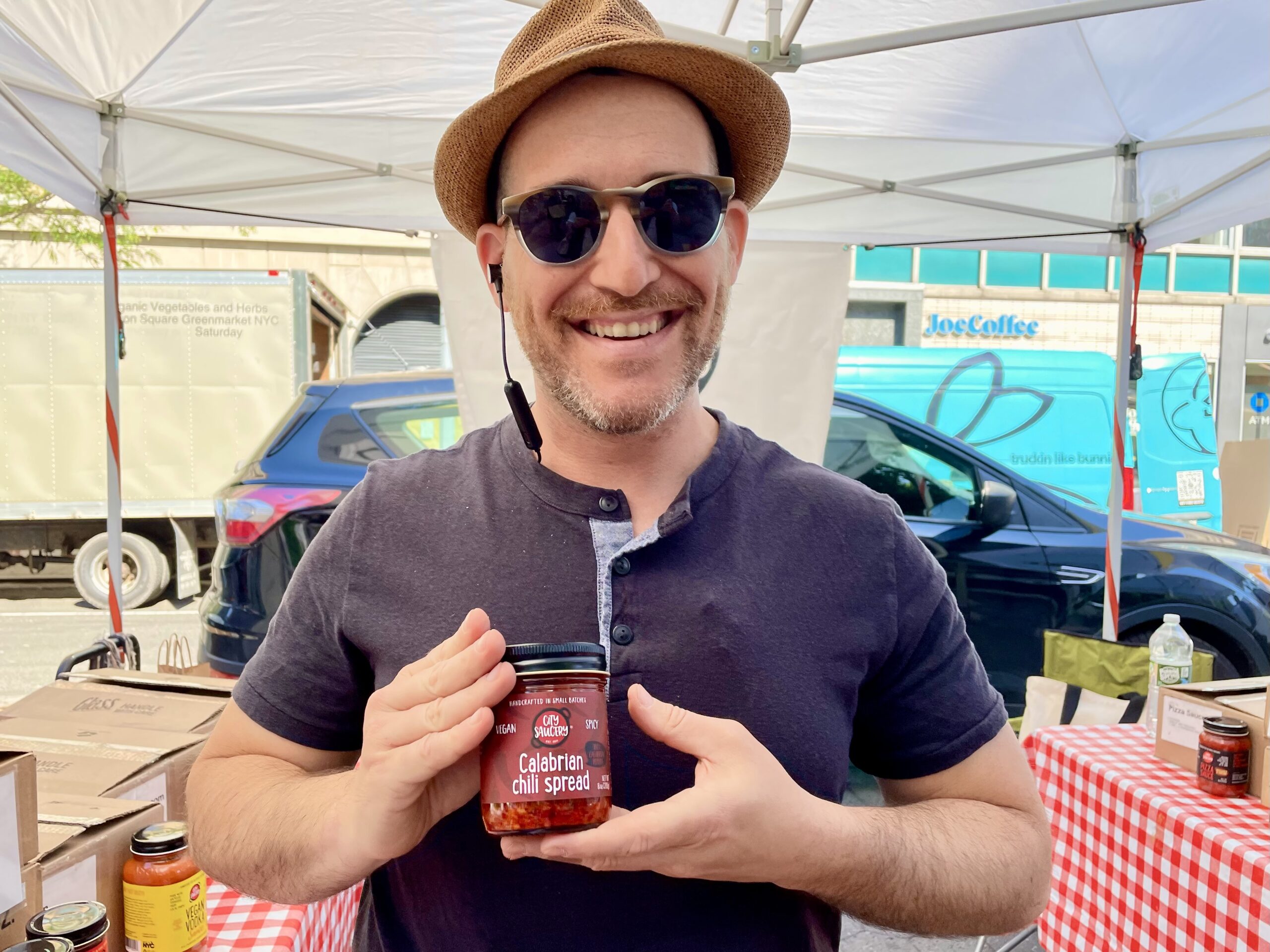Bonnie: I first tried hummus during my trip to the Middle East in the 70s. At that time, I hadn’t a clue what hummus bi tahina, the lightly colored dip I enjoyed as part of a meze, was although I remember enjoying it. I also recall that the selection of small dishes served with it included olives, cucumber in yogurt and cold eggplant salad all served with warm pocket bread, which I now know as pita.
Those foods — hummus, tzatziki, baba ghanoush and so many other Mediterranean dishes — are more commonplace today. When I first started to make my own hummus, my guests asked what it was. No longer, as hummus at a party is more ubiquitous today than the sour cream-onion dip of yesteryear.
I like the creaminess of Sabra hummus, which comes in many flavor varieties including their classic hummus (as shown above) or flavored with olives, garlic, jalapeño, roasted red pepper, pine nuts or lemon. I like most all of them.
Oddly (or interestingly) there’s a company in Europe, also called Sabra (see photos),that I discovered shopping with my sister in her local Brussels supermarket. The companies are not related.
The U.S. Sabra also makes a healthy snack-to-go version containing hummus and pretzel crisps. We liked this enough to pack it as part of the goodie bags that we handed to our launch party guests as they left.
And when I’m not pressed for time, I make my own hummus, as it’s so easy. Just puree some garbanzo beans (aka chickpeas) with some garlic, sesame seed paste (aka tahini), fresh lemon juice, parsley and salt. If you want, you might enhance the flavor with ground cumin, paprika (regular or smoked), and olive oil.
For those of you who need exact measurements to make hummus: combine 2 cups cooked and drained (or, if canned, rinsed and drained) garbanzo beans, 1/4 cup sesame seed paste, 1/4 cup minced parsley, 3 cloves garlic, 3 to 6 tablespoons fresh lemon juice (see note that follows) and a pinch of salt in a food processor or blender. Process until smooth. Taste and adjust the seasoning.
Note: If you plan to use the hummus as a dip for fresh veggies or pita bread, use less lemon juice; as a sauce for falafel or roasted lamb, use more.
And lastly, on a slightly more detailed nutrition note than in our Factoid above, hummus, like other legumes, is a rich source of soluble fiber, which helps lower cholesterol and prevents blood sugar levels from rising too rapidly after a meal, making it a good choice for individuals with diabetes, insulin resistance and hypoglycemia.
Bryan: Hummus for me is an ultimate snack maker — as useful a dipping condiment as any salsa or, shudder, ranch dressing. It is sometimes most delectable on its own with just a bit of warm pita. Enjoy with a glass of fresh mango juice to see a great Middle Eastern version of bread, cheese, and wine. Hummus is dramatically simple to make: garbanzo beans (aka chickpeas), tahini (sesame paste), garlic, lemon juice…blend till smooth with a dash of olive oil. Wow! I just made hummus. After you get over the fact that you made a delicious and nutritious snack on your own, stop and write down the name, Sabra. Let’s not kid ourselves, only some of us like to cook anyway. Those of us not in a commercial kitchen don’t make our own condiments. I buy my ketchup, my mayonnaise, my salsa and my hummus (often two at a time) at the grocery store. I was so glad when we chose to write about Sabra because it truly is my favorite brand. Please enjoy it. If you like hummus, I’d be surprised if you haven’t seen/tried it. If you haven’t tried hummus, get a bag of baby carrots, red peppers, cucumbers, celery or any of your favorite crunchy vegetables, or just some pita bread and dip into a container of Sabra. If you like it, get inventive; spread it lightly on a sandwich (especially anything with lamb) or try it with some apple (no really, it’s good). This is one of my top picks we’ve had to date.
Eric: I love hummus. Growing up in New Haven, CT one of my favorite late-night foods was a falafel pita from the famous dive Mamoun’s. Not only were their falafel balls delicious, but their homemade hummus was delectable. Since I moved away from New Haven, I haven’t found it easy to find a good falafel and, sorrowfully, I gave up on my search for a substitute pita sandwich. What brought my addiction back to life was a recent trip to Israel where, to say the least, the hummus flowed like water. Morning, afternoon and night I dined on food with a side of hummus. Upon my return to Europe I continued my obsession and was purchasing store-bought hummus weekly. I thought I had my addiction under control until I returned to New Haven for the launch party we were hosting for the website. Cases upon cases of Sabra hummus arrived at the front door, some to be eaten and some to be given to guests in their goodie bags. Fortunately for me, we had more than enough. Before I got them in the fridge I had to make sure they were still edible. Like a true addict, I chopped up some red pepper, opened a bag of pretzels, broke out the pitas and took off the top from one of the 100s of tubs we had. For me, Sabra is one of the closest substitutes for homemade hummus. They have created a good ratio of chickpea to tahini (crucial for a non-overpowering taste). I’ll put it simply, try it.








I too love this hummus. I always keep some in the fridge at work, chips in my desk drawer for a satisfying lunch when I can’t get away from my office midday. It’s a staple in my home fridge, too. I’m partial to the one with red peppers, as is my husband.
We, too, love hummus; and Sabra hummus is our favorite!
I used to be able to buy other brands of hummus until I tried Sabra. There is nothing commercially made that can compare to its rich taste and smooth texture. My favorite is with roasted garlic, and I like to use it with Kashi TLC crackers (another great brand – Kashi). When I can get to Sam’s Club (an hour away) I buy the Sabra in a 25-oz. tub for $5.49. Otherwise, I’m forced to pay $4.49 for a 10-oz. tub in my local Harris Teeter. Although I cook quite a bit (retired), I’ve never made homemade hummus. Maybe I will try it since it is easy. I don’t know if it could be as good as Sabra — a great brand.
Have to agree with the other fans of Sabra Hummus – – delicious. Have tried several of the “flavored” ones and equally delicious.
Hello, Please can your market people tell Sam’s Club or Market Basket to carry your hummus? The only store I can find it at is Shaw’s & they are way to expensive. Sam’s used too carry it that is where I first found it & it was the larger size. Please help me out Joe in Epsom, N.H..
I tried this hummus for the first time this weekend and I was amazed. I have never been a fan of hummus but the roasted garlic is to die for. This will be on my shopping list from now on!
I am looking for stores that sell sabra salsa in bergen county n.j.
Hi Jay G! I often purchase the Salsa at a store on Queen Anne Road in Teaneck called Glatt Express. They always seem to have it. I also picked some up at Costco in Hackensack but this week they seemed to only have big tubs of Sundried Tomato hummus – really good!
My wife and I are retired.We enjoy the Classic Hummus,with pita bread. The hummus tastes great if you add a few drops of hot sauce. We also use multi-grain crackers to dip. With a cold beer,life is good.
If you enjoy the classic with a few drops of hot sauce, I’d like to suggest you try Sabra’s Supremely Spicy Hummus. It’s my new favorite.
hello, where or what store is your hummas/tahini combo product available in my area. i just moved here and i haven’t been able to find it. i live in Dyker Heights, Brooklyn NY my zip code is:11228. if it isn’t available around here. i work in lower Manhattan; zip 10004 i could buy it near my job too.
thank you…oh, btw i love your products!!
Hi there, For a complete list of stores that sell Sabra’s products, check out their store locator – http://www.sabra.com/c7/storelocator.htm. You can enter your zipcode and it will give you all of the closest locations. If your local market isnt carrying your favorite Sabra product, just ask the deli manager to order them.
Melinda-
You should look in the Jewish Grocery stores in the Boro Park or Crown Heights areas. Most of them carry it, including the Kollel store on 39th & 13th. Wear a skirt and long sleeves to avoid scandalizing the other shoppers.
I forgot to also mention Flatbush. Really, anywhere that there are a lot of Orthodox Jews, they will have Sabra Hummus in the stores.
I have a son at Northeastern University in Boston and he would love the prepakaged sabra hummus flavors with pretzel crisps.
Can i order him a supply online
Unfortunately, Sabra doesnt sell online. However, you can order from some online grocery stores, like http://www.netgrocer.com/pd/Netgrocer.com/Sabra/Hummus_with_Pretzel_Crisps_To_Go/4.30_oz/00040822011969/2D462. Also, have your son ask the cafeteria to carry them.
can you freeze???
Did you recieve ? Can you freeze it???
Sabra products are not processed to be frozen, and it is not recommended.
ARE THERE ANY COUPONS FOR SABRA HUMMUS AVAILABLE…I LOVE THIS PRODUCT, AND YOUR COMPETITORS HAVE COUPONS OFF….PLEASE SEND THEM TO ME….THANKKS
Visit the Sabra website and join the “Join and Discover” club to have coupons sent to you. http://sabra.com/c6/join.htm
Exceptionally good hummus
There is no other brand that compares to Sabra. For many years I made my own because the store brands tested too tart or not enough of this or that – Sabra is better than any hummus I’ve ever made and it rivals the homemade hummus you get in the Middle Eastern stores. My local Costco now sells little portable two oz containers that come in a pack of twelve – perfect to pack in a lunch box with some carrots. It is such a guilt free snack! Just wish my local grocery chain would start carrying it but its a bargain at Costco..
Well I don’t think it was helpful at all. The question wasn’t answered. She asked about sabra coupons and never go an answered.
Her question was answer about the coupons by Stephanie in the post right below her question about coupons, not sure how you missed that judy.
Kroger’s were giving samples of Sabra pine nut hummus on these new cheddar flavored pita chips (can’t remember the brand)…that was 2 days ago and I’m stilling thinking about how great the combination was. Buying some of both tommrrow before the game.
I am actually enjoying some roasted garlic Sabra hummus at this moment. It is just lovely. I usually make my own red bell pepper hummus myself but I haven’t felt like breaking out the Magic Bullet lately.
[…] Sabra Hummus: Mediterranean Pizza March 18, 2010 Here’s a Greek version of our American classic. It’s quick and easy using Sabra hummus! […]
I love this hummus. It’s the only one I’ll eat. I get it in indivual servings (a package of 16) at Costco. I am wondering if it can be frozen. Does any know? Thanks.
For the past two or three years I have enjoyed the delicious taste of the “roasted garlic” flavored hummus plus a few of the other flavors. I have been trying all day long trying to obtain a coupon which would be greatly appreciated. I was informed that the promotion is over for now. When your next promotion occurs would you please send me a printable coupon via my e-mail. I am a fan as of today on facebook. I know this is a very healthy treat for me. Thank you, Elaine Small
I’ve tried other humus, but this is the best by far that I ever tasted. I would appreciate it if you could send me a coupon . I especially like the roasted red pepper humus.
Sincerely, Marie
Marie, Wish we could! We’re not the official Sabra Hummus site – we’re just foodies who love and have written about their hummus. We’ve been trying to get Sabra to offer a giveaway of hummus or coupons in Bite of the Best’s FREEBIE section. I’d have to nudge them again. Stay tuned!
They sell it at Costco, try to figure out when they’re giving free samples.
Can you freeze Sabra hummus?
I tried some bad hummus (not Sabra brand) before and I didn’t like hummus for the longest time. It’s ironic because I’m a vegetarian and I love chick peas! My fiance loves hummus and he tried to convince me to give it another try, but I resisted.
Recently, a close friend of mine told me to take a small scoop of hummus Sabra brand with Wheat Thins Reduced Fat crackers and it tasted so good. I’m hooked on Sabra hummus 🙂
I tried about 5 flavors so far and my favorite is with the red pepper. I’m so glad there are lots of flavors to buy…yummmy.
Freezing Sabra hummus is not recommended, as it will mess with the consistency of the product.
I first discovered Sabra brand hummus while house sitting for some friends. They are healthy Granola types and normally they had nothing in their pantry or frig that would look apetizing to me. But this one time during a snack attack I discoved a big tub of Sabra Chipotle hummus. OMG Chipotle! It just happens to be one of my favorite flavors in the world. I do not consider myself a health nut, but Sabra brand hummus is now a staple in my home – my favs are the Chipotle and the Supremely Spicy Flavor.
hi to all at http://www.biteofthebest.com i thought i had sent this newyears eve but it didnt send so i have sent it again all the best for new year to you all
– matty
I LOVE Sabra hummus especially the jalapeno. I love it with low fat baked blue corn chips. I keep 2 10 oz containers in my refrigerator at all times, and when I travel, I wrap the container in plastic and pack it as I can never find the jalapeno hummus anywhere but New York. I just bought 2 new containers and I paid 4.29 each which I think is too much. I asked the store manager and he had no idea why it was so much and the Tribe hummus was 2 for 1.99. I am curious to see the the average price of Sabra’s 10oz container in other stores. All in all, Sabra is the creamiest and tastiest and I have been eating it for years.
I avoid Sabra hummus. They had a massive listeria outbreak.
I tried to contact them but they took down all forms of electronic contact.
There are better brands out there.
Thanks for sharing. Did you try https://sabra.com/contact-us? They offer many options for connecting. Or call them at 1-800-657-3001 M-F 9:00-5:00 EST.
[…] its consistency and flavor. That being said, several patrons have tried freezing Sabra hummus and got great results. If you must freeze the hummus, do so with reasonable […]